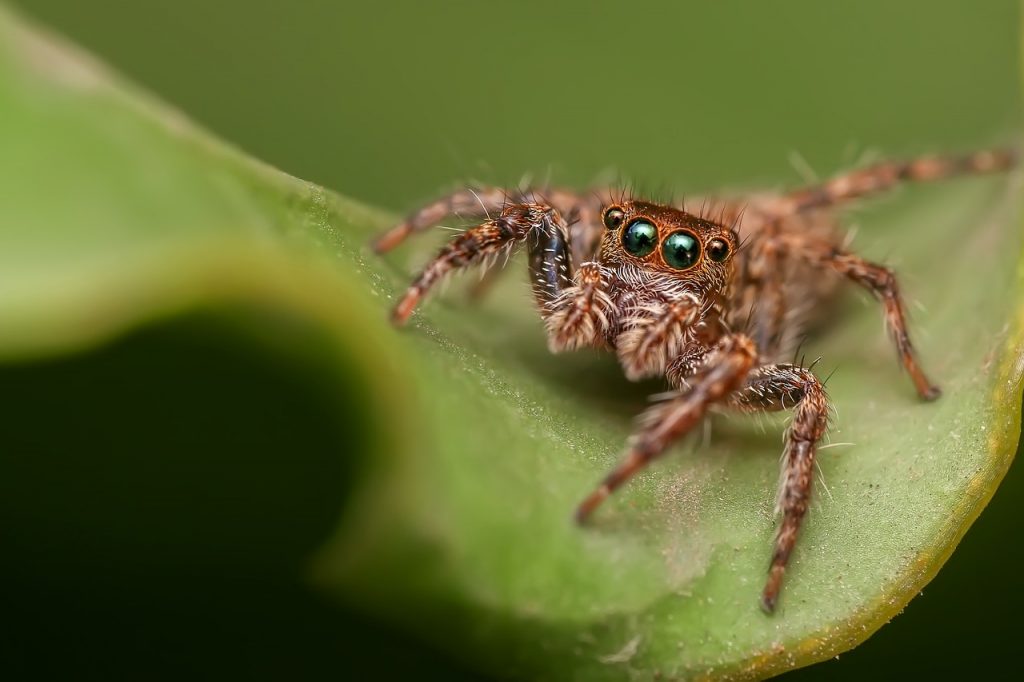3 Fascinating Facts about Jumping Spiders!
Did you know that the smartest arachnid is the Jumping spider also known as the Portia fimbriata? Jumping spiders got their name from their unique ability to jump especially when pouncing on their prey. Before you start thinking you will never encounter them anywhere near your home, Jumping Spiders are everywhere.
Although they are lovers of areas with tropical climates, in 1975 they were spotted on the slopes of Mount Everest showing their spread all over the world. Jumping spiders have amazing eyesight, and you can never scare them from behind, why? They have eyes even at the back of their heads. Here are some more fascinating facts about jumping spiders:
They have ultimate senses

The interesting thing with jumping spiders is that they do not have ears. However, they have such high vibration senses that they can sense any movement near them no matter how silent the movement is. This means if they are in your home and you are trying to hit them, they will have sensed you way before you lift a finger and you will have no victory.
Spidey-senses weren’t just invented for comic books. Jumping spiders in real life have sharp eyesight and excellent hearing to make up for their inability to spin webs. Scientists long assumed that spiders couldn’t hear because they don’t have ears. But as researchers reported in a 2016 study, jumping spiders can “hear” perfectly fine—they just use the super sensitive hairs on their legs to do so. These same spiders can also see surprisingly well, as astronomer Jamie Lomax demonstrated when she used laser pointers to lure them away from her desk like they were tiny cats. Read more from Mental Floss…
They make plans before attacking

It is said if you fail to plan, you plan to fail. Little was it known this was true even for spiders. The hunting strategy of jumping spiders involves observing their prey and making plans on how they are going to attack them. A research was conducted at the University of Canterbury to test it out and here is some snippet into it:
Cross and Jackson put Portia’s mental abilities to the test in the laboratory. They built an apparatus with a central viewing tower on a platform, surrounded by water, from which a spider can see two other towers topped with boxes: one containing dead spiders that Portia likes to prey on, and one with dead leaves. The only way to reach the prey without getting wet, which jumping spiders loathe, is to climb down onto the platform and then choose the correct one of two separate walkways leading to the boxes.
From the perch atop the viewing tower, the spiders carefully surveyed the scene before descending the tower and climbing up a walkway. Most spiders chose the path that led to the meal, even if this meant moving away from the prey and passing the incorrect walkway on the way. Read more from Knowledgeable Magazine…
These spiders seemed to observe first the route that they would take. They would then work it out meticulously which was something to wow at considering how small their brain is.
They can differentiate between living and nonliving creatures

It is amazing that jumping spiders can differentiate between living and nonliving objects. To do this, they use tactics that human beings and other large creatures use. This is through their sight. Living creatures tend to have distinct movement abilities compared to nonliving objects and the spiders use this to their advantage.
This is well illustrated through the research experiment below:
The researchers tested their dots on 60 jumping spiders of the species Menemerus semilimbatus, which were selected because of their unusual visual system. Their two large central eyes are understood to be the most capable, but they lack a wide field of vision. That’s where the secondary eyes that wrap around the head come in. When these secondary eyes spot something interesting, the spiders direct their two large eyes toward it for a closer look.
This is exactly what happened when the spiders were shown an animation that moved in an unfamiliar, non-lifelike way. They appeared concerned. They swung their two large eyes toward these incomprehensible objects, apparently in an effort to make sense of them. This was especially true when they were shown animations exhibiting totally random, nonsensical movement.
However, for animations that moved like a living creature, the spiders remained still. Read more from Big Think…
With this in mind, you should be careful when it comes to dealing with any infestation of spiders in your compound. You don’t want the spiders using these tricks on you. You will need a professional who has the necessary knowledge and experience in dealing with spiders. At Backyard Bug Patrol we have spider control experts. If you need any, Call Us Today!
